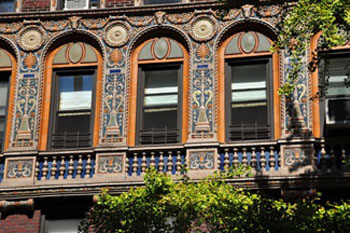Product Description
Eugene Schopin French Renaissance Revival Style Majolica Wall Shelf c.1872


Eugene Schopin (1831-1893) Montigny-sur-Loing, France.
Renaissance-Revival style Majolica wall shelf, circa 1872.
Hand modeled and cast ceramic with highly stylized caryatids and floral details glazed with rich cobalt blue, green, gold and cream colored glazes.
Marks: M-S-L (Montigny-sur-Loing), RA.
H: 8 ½” x W: 14” x D: 6 ¾”.
Eugene Schopin founded his ceramic factory in Montigny-sur-Loing in 1872. Painters like Jean-Baptiste Corot, Eugène Thirion (1839-1910), Adrien Schulz (1851-1931), Numa Gillet (1868-1940) and Lucien Cahen-Michel (1888-1980) were attracted to this area by the beauty of the landscape and light. Eugene Schopin collaborated with these artists to create a range of models inspired by Impressionism and decorated according to the new demands of the public.
Eugene Schopin French Renaissance Revival Style Majolica Wall Shelf c.1872
MAURICE BOUVAL (born Toulouse, died 1920) France
M. COLIN France
“Nymph Embracing a Blossom” candle holder c.1900
Silvered cast bronze in the form of a nymph on a leaf embracing a blossom
Marks: M. Bouval (script signature) and COLIN, (Foundry) written above
For other examples of Bouval’s work see: The Paris Salons 1895-1914, Vol. V: Objets d’Art & Metalware, Alastair Duncan (Woodbridge, Suffolk: Antique Collectors’ Club, 1999), p. 127; Ecole to Deco, Small Sculptures from a Private Collection, Stephen C. McGough ed. (Oberlin, Ohio: Allen Memorial Art Museum, 1979) pp. 33-4; Art Nouveau Sculpture, Alastair Duncan (New York: Rizzoli, 1978) pp. 30-1.
H: 3″ x W: 6 1/2″ x D: 4 3/4″
